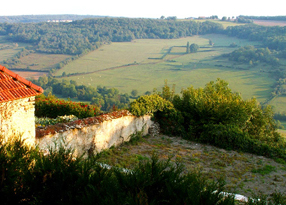
Whenever I mention that I’ve been biking in Burgundy, people assume that I’ve been touring vineyards. With each trip they imagine that I’m increasingly knowledgeable about the Pinot Noirs and Chardonnays that make the great reds and whites of the Cotes de Nuits, the Cotes de Beaune, and Chablis. But even though I’ve learned a thing or two about wine during my travels, I typically end my biking days with a beer. And it’s the history of the woods that has interested me more than the history of the vines.
This is especially true in my two-wheeled explorations in and around the Morvan Regional Natural Park, a vast, lightly populated, protected green zone covering 1100 square miles in the center of Burgundy that’s exceptional for cycling, farms, forestry and history.
Celts and Romans
Three thousand years ago, during the Bronze Age, the area was inhabited by the Celts. Early merchants carried tin from Cornwall to the Mediterranean regions using the valleys of the Seine and Saône, and through Alsace, southern Germany and the Danube valley.
Around 100 B.C., the control of these routes allowed the Eduan tribe of Celts to establish power over most of what is present-day Burgundy. Their center of authority was Bibracte, an oppidum (or fortified settlement) at Mont Beuvray in the southern Morvan. That’s where the united Celtic tribes elected Vercingétorix chief to repel the Roman army under Caesar. The name Vercingétorix fills Frenchmen with pride since he was a homegrown hero brave enough to go up against an invader. He was nevertheless soon defeated.
From his camp at Flavigny-sur-Ozerain, Julius Caesar directed the final defeat of Vercingétorix and the Celtic tribes at Alesia, at the top of a nearby hill, in 52 B.C.
Caesar wrote that the Celts fought naked, perhaps as a way of saying that the men they set out to defeat were less than human, but in these warrior tribes men and women wore full armor, including chiefs and elders, who fought side by side on small horses. The Celts had a flourishing civilization. In the second and first centuries B.C. men shaved with obsidian razors, made fine jewelry, enjoyed wild boar, and imported oil and wine from Italy. These were tall people and had long blond hair. The hair color may have come from washing in a lye solution to rid their scalps of various critters.
Archeologists estimate that prior to the Celts’ conquest by Julius Caesar, traders brought 40 million amphorae (two-handled pottery jugs used to transport liquids such as wine and oil) into Gaul. After Caesar’s conquest, there was a decrease in the wine traffic as, instead of wine that easily turned to vinegar en route, Romans brought vines and their winemaking methods to eastern Burgundy.
Cycling around the Morvan has allowed me to acquire a sense of how Celts and Romans might have lived 20 centuries ago. In spite of small paved roads (a few following old Roman roads) allowing easy access, the rocky hills are covered with square mile after square mile of mature, dark forests. There are probably more villages now, but fewer permanent inhabitants.
From Forest to Wood for Paris
By fits and starts through the Middle Ages France became an increasingly powerful and centralized kingdom as far as most Parisians were concerned. But not much changed in the Morvan.
Paris only began paying attention to the Morvan—and perhaps the Morvan to Paris—because of the rich supply of wood in the area. Paris managed to find sufficient wood within its own surrounding region through the Middle Ages, but by the early 16th century that resource was nearly depleted. The kings, starting with Francis I, would not allow woodcutting in the royal domains that they reserved for hunting. Some wood was coming from northwest Burgundy by oxcart, but this was slow and costly.
In 1545, someone came up with the scheme to raft wood down the Cure River to the Yonne River, the Seine River and into Paris. It was a good idea but he had no funding. Charles Leconte, a native of Nièvre and prime carpentry contractor for the City Hall of Paris, then jumped on the idea and obtained funding.
On 20 April 1547, Leconte brought the first profitable raft of logs on the Yonne to Paris. Two years later an epic number of logs began floating to the capital.
This enterprise thrived for nearly 300 years, until wood was displaced in Paris by charcoal and then coal. At its peak, the annual volume of wood down the Yonne provided 90% of heating wood for Paris, exceeding 900,000 cubic yards of wood per year.
The annual cycle of selling and floating wood started on All Saints Day, 1 November, when the previous year’s wood harvest was auctioned at Châtillon-en-Bazois to 22 brokers by the owners of the forest properties. Within 15 days, the crews of those brokers and the forest owners marked each end of each length, called hammering, with a registered brand. These marked logs were stacked close to streams that ultimately flow to the Yonne. They were then moved into the streams in preparation for the “small wave” that started on 15 November. To obtain a sufficient flow of water, many reservoirs (made for this purpose) released water. Men and boys lined the streams and threw logs back into the flooding streams. This took the upstream logs to the 22 accumulation ports at the streams’ confluence with the Yonne.
After 15 November, the upstream reservoirs were dammed and an army of workers swarmed back into the Morvan forests for the winter to cut logs for the following year’s auction.
By 15 March, winter snows melted and the reservoirs were full again. Early that morning, water was released and marked wood from the accumulation ports flowed into the Yonne and on to Clamecy. All along the Yonne, men and boys risked their lives pushing the logs back into the river. The wave of wood was enormous; the river was covered with logs many feet thick and miles long.
Five hours later the residents of Clamecy, 20 to 30 miles downstream, heard the thunder of the approaching “Great Flood.” That was the signal to gather along town’s riverbanks to watch the logs arrive. With the initial roar of logs, the temporary wood dams below Clamecy were closed to raise the Yonne level and stop the flow of wood.
On the river banks, workers—men, women and children—drew wood out of the river with spiked poles up to 12 feet long. Women and children sorted the recovered logs and loaded them on special wheelbarrows. Then the wood was distributed to 30 workshop areas near the river depending on the logs’ marking.
The sorted logs were stacked 10 feet high with layers in alternating directions, roughly 5 cubic yards. There the wood dried until November.
In November, as the annual wood auction began way up stream, teams of six experienced workers in Clamecy assembled individual and complex rafts of logs, 250 feet long by 15 feet wide, with about 200 cords of wood. They then slid and levered the rafts into the Yonne and the next phase began. Two people were on each raft, the floater (a male adult) and his “little man in the back” (a teenager). When the raft got past the narrows upstream from Auxerre, the teenager left the raft and walked back to Clamecy. The floater guided the raft the rest of the way north down the quieter Yonne to the Seine and on to Paris, 155-mile ride that took 10 to 15 days.
Then innovation intruded into life along the Yonne. By the end of the 17th century the French had become master builders of canals and were extending the canal network throughout the kingdom.
Construction of the Canal du Nivernais began in 1784 with the goal of connecting the Loire basin with the Seine. This final 113-mile waterway for barges up to 99 feet in length and 16½ feet in width, including 110 locks and three tunnels, was finally inaugurated in 1841.
Paris had then started turning to coal for heat, and the Canal du Nivernais was also transporting upwards of 100 tons of coal per barge. With all that excess wood, the shops in Clamecy started making and shipping charcoal.
Canal tourism by barge and by bike
Commercial traffic along the Canal du Nivernais declined when a rail line was built nearby. That could have been the death of the canal.
Then Pierre Zivy pioneered canal tourism in France. The Canal du Nivernais had been effectively abandoned and was overgrown with vegetation. Between 1965 and 1970, traffic was virtually non-existent and there was consideration to close the waterway. But Zivy saw a future in the canal and put forward a plan. The region of Burgundy, supported by local and national funding, stepped in with money, renovating locks, tunnels, bridges, and the waterway for exclusive use of pleasure boats. To the great pleasure of cyclists like me, they implemented bicycle routes throughout the region, with old towpaths upgraded and paved for much of their length.
I rode here for a week in spring when the area is green, temperatures are moderate and the risk of rain acceptable. A bike path runs along the length of the canal, allowing easy cycling for those who wish to avoid hills, offering a leisurely pace during which to visit surrounding villages and absorb local culture and history. There are plenty of decent restaurants, and those in search of Burgundy wines and wine knowledge can certainly find them. Undoubtedly, fewer people here speak English than in the more popular eastern Burgundy wine region, but whenever I attempt a little French, even just a greeting, conversation thrives.
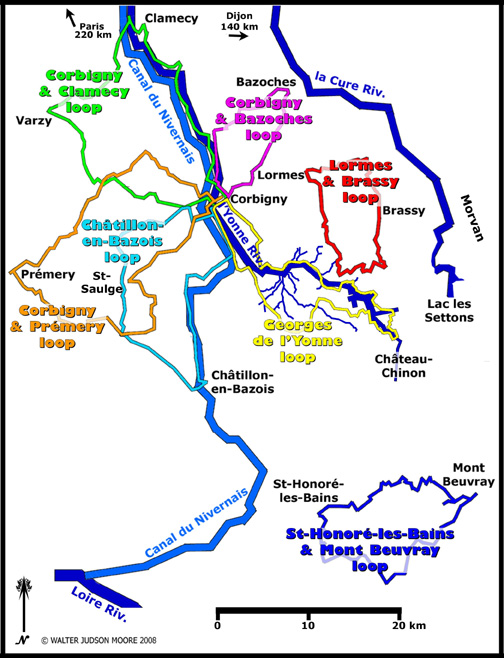
Along the gentle slopes above the canal, I bicycled through a couple of small villages and a section of woods that seemed right out of the eighteenth century, albeit with a wider and paved roadbed.
To get an idea where the annual wood auction took place, I rode south along the canal to Châtillon-en-Bazois. In addition to a few normally spaced locks, the canal flows through the Sardy Locks Ladder with its 16 locks and the three Collancelle Tunnels at the highest elevation of the canal. Built into each tunnel is a towpath just wide enough for a man to walk pulling a barge, but not wide enough for a weary horse that might misstep into the canal.
Discovering a new part of France by bike is always gratifying for me, whether the day ends with a glass of beer or a glass of wine. I thank Pierry Zivy and his appreciation for the canal for this one.
My appreciation for the lives of the Celts, the early foresters and floaters, Caesar’s legionnaires and residents of then smoky Paris increased during my week in the Yonne Valley and along its canal. The gîte I stayed in was clean and warmed with electric heat. The roads and bicycle paths were smooth. There were no critters trying to take up residence in my scalp. And I didn’t have to defend against invaders while cycling up Mount Beuvray, though I did once have to dodge a group of archeologists while barreling down a hill.
Text, photos and cycling map © Walter Judson Moore, 2011.
Walter Judson Moore is the author of four cycling guidebooks to France and three companion queue sheets. His guide “Bicycle Your France: Secret Burgundy” includes the area covered by this article. His work is available Lulu, Amazon and other online booksellers as well as directly (and personally signed) from the author, who may be reached at bicyclemoore@tampabay.rr.com.
More history of the wood commerce on the Yonne can be found here.
Official website of the Nièvre Department Tourist Board, specifically biking information.
Site of Les Amis du Canal du Nivernais (Friends of the Nivernais Canal).
Official website of Morvan Regional Natural Park.
[Comments may be left at the bottom at this page.]


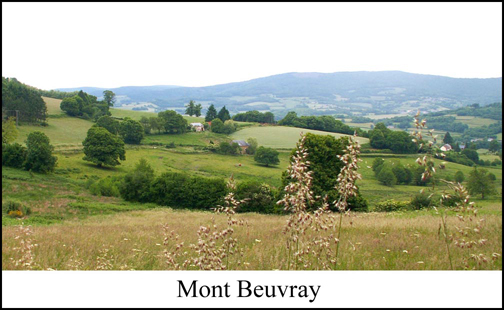
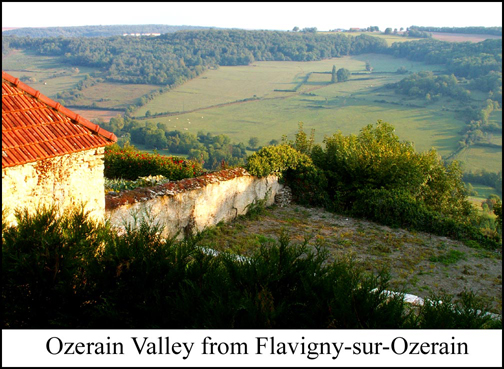
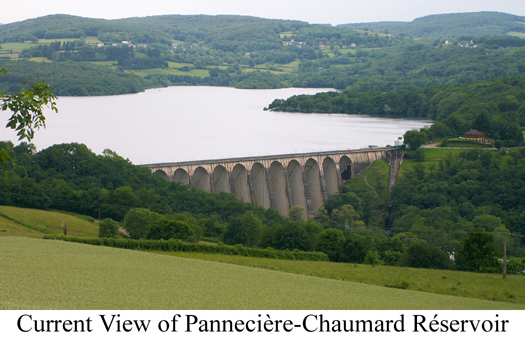
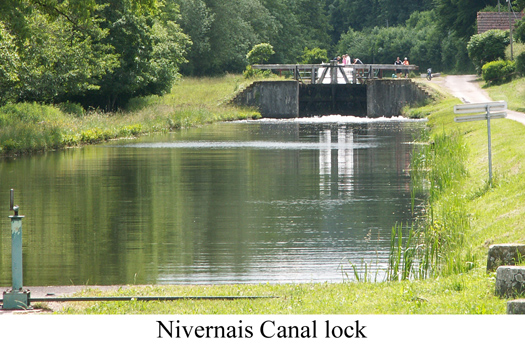
Sounds like you had an interesting adventure.
History and biking all in one place…what a pleasure. Thank you for the excellent article.
MB
Great article , Fantastic pictures and scenery.
We “found” Le Morvan in 2010 and have just returned from spending this years holiday there as well, It is so very much what we like that we think we’ll be returning for a few years yet – plans for next year have already started. So to read your articles, Walter, is a joy. Not only do you unearth facts that we have not (and we have keen noses) but your ability with the written word is first class. Informative, interesting and so easily digsted. The fact that you are a fellow cyclist allows us to forgive you for telling “the masses” about a region that we would like to see kept a secret – but that’s selfish and there is so much space, more numbers will not matter. Thanks, Walter, another superb piece.
What an interesting past the Morvan has…this whets my appetite for a cycling trip there…great photos and writing, too.
Always informative and a delight to read. Thanks for sharing
with all us simple folk here on the trail.
Your information is always wonderful to read – it gets one excited about biking ..your book came in handy on our month biking trip in France last year. Great pictures. Thank you
Enjoyed your article on Burgundy history. A real step back in time. Excellent
Great article and insight for all cyclists
Great touring information along with some interesting history.
It is always a great pleasure to read Walter’s articles. This time it is not only a pleasure, this time I learned a lot of new things. And as usual this lively interest to the subject Walter shows in all his works! I read and re-read information he has given in the article. Plus pictures are really marvelous; it’s a pity there are so few of them. Thank you!
Thanks Ludimila. I will send you a photo disc of the published photos from my four guidebooks.
Hopefully, it’s better late than never for me to join appreciations of this article. The history background of places one visits always makes any trip much more worth. The above story easily proves it. Very much hope and wish more and more people to use Mr W. Moore’s traveling experience and professionally written guides in practice.